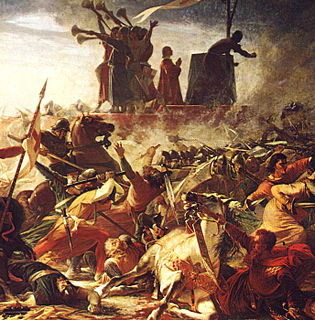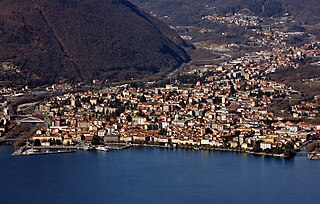Related Research Articles

Lombard is a Gallo-Romance language, consisting in a linguistic continuum spoken by millions of speakers in Northern Italy and Southern Switzerland, including most of Lombardy and some areas of neighbouring regions, notably the eastern side of Piedmont and the western side of Trentino, and in Switzerland in the cantons of Ticino and Graubünden.

The Battle of Legnano was a battle between the imperial army of Frederick Barbarossa and the troops of the Lombard League on May 29, 1176, near the town of Legnano in present-day Lombardy, in Italy. Although the presence of the enemy nearby was already known to both sides, they suddenly met without having time to plan any strategy.

Legnano is an Italian town and comune in the north-westernmost part of the Province of Milan, about 20 kilometres (12 mi) from central Milan. With 60,259, it is the thirteenth-most populous township in Lombardy. Legnano is located in the Alto Milanese and is crossed by the Olona river.

Associazione Calcio Dilettantistica Legnano, commonly referred to as Legnano, is an Italian football club based in Legnano, Lombardy. Founded in 1913, Legnano played three seasons in Serie A and a total of eleven seasons in the top tier of the Italian football league system.

A Carroccio was a large four-wheeled wagon bearing the city signs around which the militia of the medieval communes gathered and fought. It was particularly common among the Lombard, Tuscan and, more generally, northern Italian municipalities. Later its use spread even outside Italy. It was the symbol of municipal autonomy. Priests celebrated Mass at the altar before the battle, and the trumpeters beside them encouraged the fighters to the fray.

Alberto da Giussano is a legendary character of the 12th century who would have participated, as a protagonist, in the battle of Legnano on 29 May 1176. In reality, according to historians, the actual military leader of the Lombard League in the famous military battle with Frederick Barbarossa was Guido da Landriano. Historical analyses made over time have indeed shown that the figure of Alberto da Giussano never existed.
San Giorgio su Legnano is a comune (municipality) in the Metropolitan City of Milan in the Italian region Lombardy, located about 20 kilometres (12 mi) northwest of Milan.

Villa Cortese is a comune (municipality) in the Province of Milan in the Italian region Lombardy, located about 25 kilometres (16 mi) northwest of Milan.

San Giorgio Morgeto is a comune (municipality) in the Province of Reggio Calabria in the Italian region Calabria, located about 70 kilometres southwest of Catanzaro and about 50 km (31 mi) northeast of Reggio Calabria. As of 31 December 2004, it had a population of 3,356 and an area of 35.1 square kilometres (13.6 sq mi).

The Olona is an Italian river belonging to the Po Basin, 71 kilometres (44 mi) long, that runs through the Province of Varese and Metropolitan City of Milan whose course is developed entirely in Lombardy.
The Canegrate culture was a civilization of Prehistoric Italy which developed from the recent Bronze Age until the Iron Age, in the areas of what are now western Lombardy, eastern Piedmont, and Ticino. Canegrate represented a completely new cultural dynamic to the area expressed in pottery and bronzework, making it a typical example of the western Hallstatt culture.

The Company of Death is the name used in the historical literature of English language for two related chosen tactical corps, two selected bands of warriors, entrusted to guarantee the cohesiveness and efficiency in battle of both the Milanese and Lombard League's militias through their bond by oath to the defence of the Milanese Carroccio, the wagon on which the standard of the Lombard allies stood.

The Campaccio is an annual cross country running competition which takes place in early January in San Giorgio su Legnano, Italy. Organised by the Unione Sportiva Sangiorgese, the event attracts participation from Olympic and world champions in athletics, in spite of the fact that the host town has a population of just over 6000. It is typically the first major athletics event of the year in Italy, and holds IAAF Cross Country Permit status.

Intra is a frazione of the municipality of Verbania, in Piedmont, northern Italy, located in a small alluvial plain. It is important for its port on Lake Maggiore and attendant tourism. In Intra in 1905 was founded Zust, an Italian car manufacturing company, by engineer Roberto Züst, an Italian industrialist of Swiss origin, In 1909 was founded a rowing club, Canottieri Intra. The main church is a basilica dedicate to San Vittore. The basilica di San Vittore was rebuilt during the first decade of XVIII century.

Gaetano Cozzi was an Italian historian, professor at Padua University, and researcher with the Giorgio Cini Foundation and Fondazione Benetton Studi e Ricerche. He was a specialist in Venetian history, with special attention to the institutions, the relationship between law and society and the cultural environment.

In the 1953–54 season, Internazionale competed in the domestic league as the defending champion.

Legnano, an Italian municipality of the Metropolitan City of Milan in the Alto Milanese, has a recorded history from the first mention of the Legnarello district to the present day.

Beata Vergine Assunta is the parish church of San Giorgio su Legnano, a municipality in the Metropolitan City of Milan, in Lombardy. Dedicated to the Assumption of Mary, it was consecrated on April 23, 1935. It has a Neo-Renaissance style and is characterized by a central plane of Bramante derivation.

The Visconti Castle of Legnano is a mediaeval castle, located south of the city of Legnano, Metropolitan City of Milan, Lombardy, northern Italy. It lies on a small island formed by the Olona river. Since the 13th century, it is also known as the castle of San Giorgio.

The Italian Numismatic Institute is an Italian body for the study of numismatics, based in Palazzo Barberini at 13 via Quattro Fontane.
References
- 1 2 Attilio Agnoletto: San Giorgio su Legnano - storia, società, ambiente. 1992, p. 18.
- Literature by and about Guido Sutermeister in the German National Library catalogue